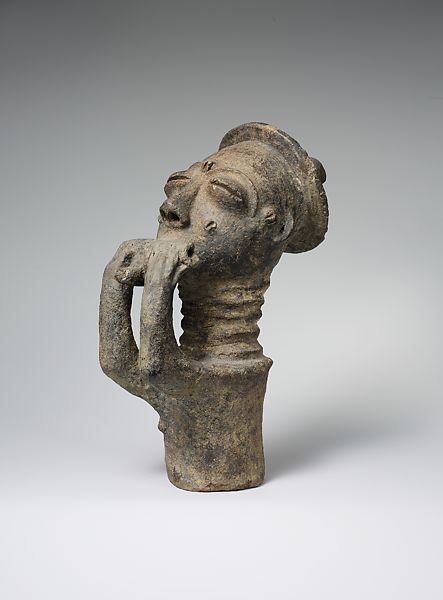akan.
akan
Memorial Figure of a Hornblower, Akan Peoples, 18th - Early 20th Century
Akan and the afterlife, more specifically.
From the 16th century, the Akan peoples of West Africa (predominantly Ghana) have given expression to their beliefs about death and the afterlife through the medium of clay, with terracotta sculpture produced by Akan women playing a key role in funerary rites to memorialize the dead.
Burial sites of ordinary people were marked with decorated terracotta vessels commissioned as gifts to the deceased, while royal graves were accompanied by freestanding clay heads and figures. When a ruler died, a memorial sculpture was created in his likeness and brought to the cemetery in which he was buried. It was left there alongside images created for previous generations of rulers, forming a display that was the focus of annual rites celebrating the memory of royal ancestors. Sculptures of servants, musicians and other court attendants were also placed at gravesite, to comfort and serve the dead ruler in the afterlife.
Forms range from seven to ten centimeters wide to life-size, and from hollow and rounded, to solid, flat and circular. One of my favorite African sculptures at the Met is ‘Memorial Figure of a Hornblower’, a wonderfully expressive 10 inch high clay figure of a court musician playing a cylindrical flute that makes me so happy to look at. The Met have estimated him to be from somewhere between the 18th - early 20th Century (accurately dating African art can be extremely difficult). His brimmed hat suggests courtly status, while the raised marks on his cheeks, temples and forehead are skin embellishments denoting ethnic affiliation.
These funerary forms and the gravesites in which they were placed also served an important function for Akan women with fertility issues, who would visit and leave offerings in the hope that the spirits of the dead would aid them in conceiving.
Memorial Head, Akan Peoples, 17th - Mid 18th Century. In much of Africa, clay is an artistic medium primarily associated with women.
Memorial Head, Akan Peoples, c. 17th Century



